Stories > Stitches That Connect
Stitches That Connect
As sheltering-in-place isolates countries, cities and people, the Stay At Home Quilt project forges a new connection between different social-economic classes, cultures and nations.
BY ANNIE TAN
ome 15 Singaporean volunteers ventured into one of many temporary dormitories that housed migrant workers during the pandemic.
Over curry puffs, they got to know about 30 migrant workers from India, Bangladesh and China, many of whom had already been in quarantine for a few months in a bid to control the local transmission of Covid-19.
This socially and culturally diverse group then did something many of them would not usually do: With some cloths, threads and needles provided, they started sewing together. Many of these migrant workers and volunteers did not have any sewing background, but at the end of the threehour session, each had created a unique artwork on fabric that reflected their Covid-19 experience.
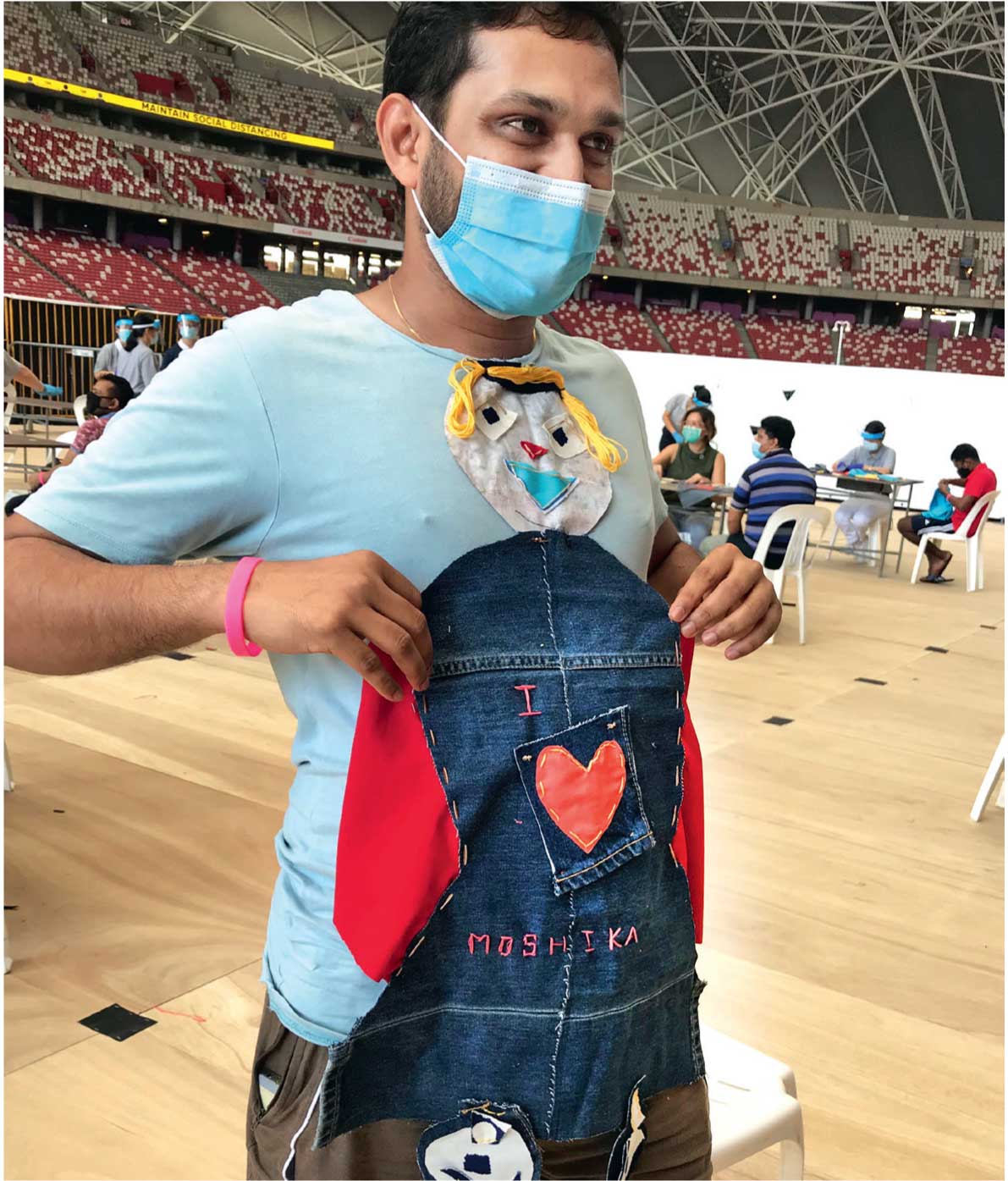
Stay At Home Quilt started as a geographically focused project by an arts-based non-profit, which later expanded to include migrant workers in Singapore to collectively express their emotional state of mind during the lockdown phase.
A 24-year-old migrant worker sewed a simple “S” in a heart in fond remembrance of his mother. One created a child-size shirt with a red heart for his young son whom he missed dearly. Yet another made a doll for his year-old daughter fashioned from scrap materials. This was the first of three sessions of the Stay At Home Quilt project to include migrant workers.
A PATCHWORK OF IDEAS
The brainchild of Singaporean artist Jimmy Ong, Stay At Home Quilt is a collaborative project with Lin Shiyun, creative director of non-profit arts company 3Pumpkins. The initial plan was to focus geographically on the residents of Lengkok Bahru, where a large number of elderly people and families under social assistance schemes resided.
However, when the Circuit Breaker – a government mandated stay-at-home order with elevated safe-distancing measures – began in April, physical meetings and gatherings became impossible, making it difficult to connect with the community.
As a workaround, the team made an open call for participants online, and sent out sewing kits.
The project is one of many Singapore International Foundation’s Arts for Good (A4G) projects, which brings together international artists and different sectors of society to create arts-based initiatives that enhance cross-cultural understanding and create social impact. Recognising the global impact of Covid-19 on the arts and culture scene, the SIF has ramped up its support for the work of arts practitioners to help different communities in need.
“We started asking local participants to make the patchwork as a contemplative activity while they were isolated at home, connecting in solidarity with others who were also in quarantine and with those who have suffered, to resolve to regain calmness in order to flatten the Covid-19 curve together,” shares lead artist Ong.
American artist and expectant mother Kristin Dwek reflected on her impending motherhood through her creation, and Singaporean theatre director Jeffrey Tan dedicated his quilt to frontline workers and those who had lost their mothers.
Many of these quilts represented the A4G fellows’ reflections and hopes for the future. “As I sewed the buttons, I thought about social distancing where we had to be apart from our family and friends. Looking forward, the hope is to come together closely again and rejoin each other when the crisis is over, and that we can rebuild our community again with love!” says Amanda Chen, an art therapist.
As the project gained momentum, more parties got involved. Tzu Chi Humanistic Youth Centre was key among them, and suggested including migrant workers who were hard hit by the pandemic. In June, its centre manager, Lim Choon Choon, approached the Migrant Workers’ Centre to explore the possibility. While the first session was originally planned to last for an hour and a half, participants enjoyed it so much that they spontaneously doubled it into a three-hour session.
MAKING NEW CONNECTIONSIndeed, sewing a quilt could well be a fitting metaphor for bridging the divide and connecting people with vastly different lives – Singaporean volunteers and the migrant workers who have helped to build Singapore’s buildings and roads.
“The project was very challenging right from the start. Because it was a sensitive period, dormitory operators were more cautious, and many did not get back to us. At that time, the government was also doing swab tests, and on and off, migrant workers would be diagnosed with Covid-19 and there would be lockdowns,” Lim recalls.
“WE MAY BE DIVIDED BY SEAS, YET WE HAVE THIS INDOMITABLE HUMAN SPIRIT THAT ALLOWS US TO FEEL AND ACT ON THE SAME EMOTIONS. BEING PART OF A COMMUNITY IS CRUCIAL AT A TIME WHEN ISOLATION HAS BECOME THE NEW NORM,”
SAYS FILIPINO ARTIST FRANCIS SOLLANO.”
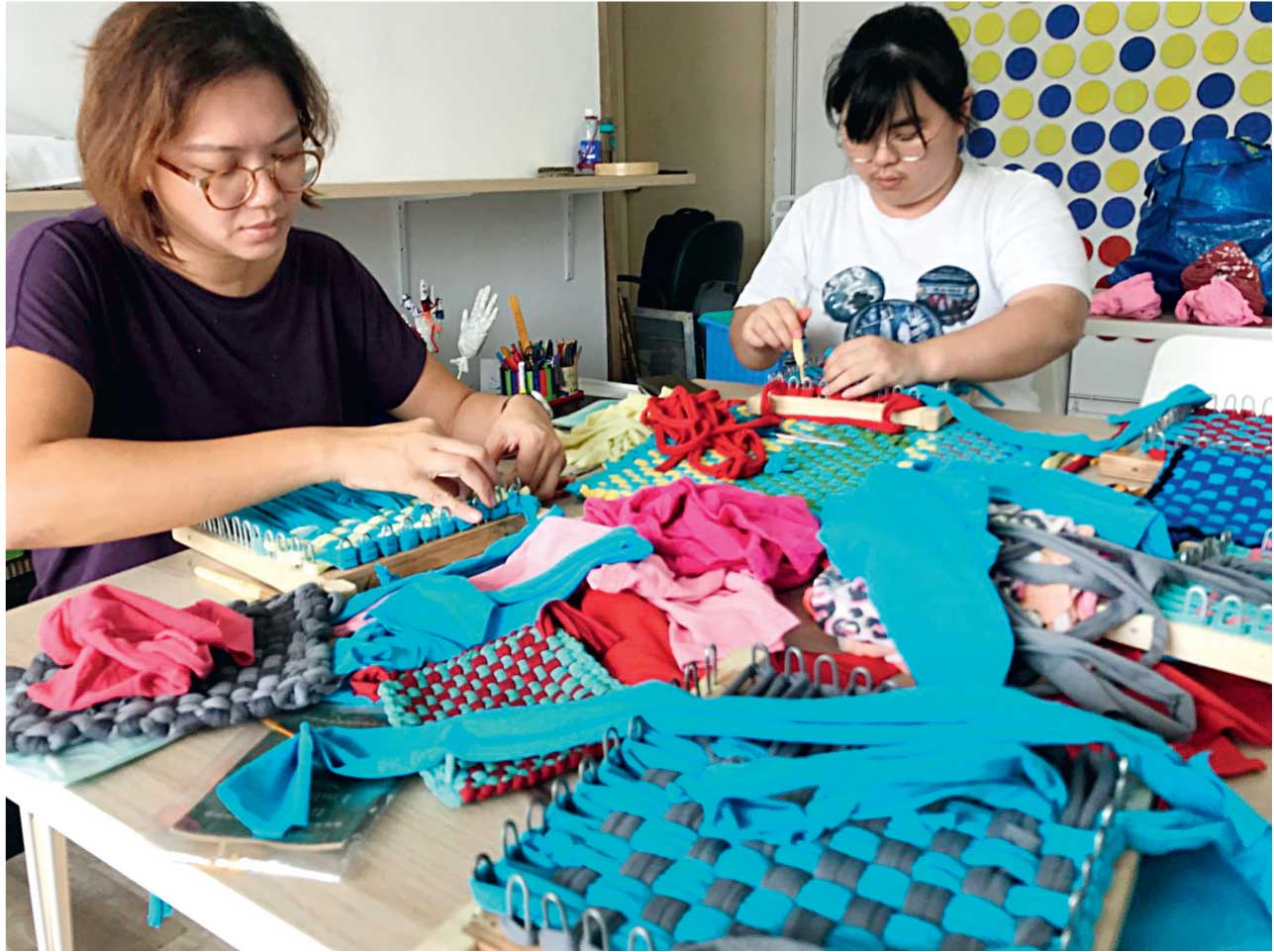
People from around the world contributed small pieces that have become part of the larger patchwork quilt project.
Although the team initially thought they could involve as many as 5,000 migrant workers, they ended up working with less than a hundred of those who recovered. These took place over three engagement events at two dormitories. Precautions included holding the events at well-ventilated spaces with protective gear such as face shields, masks and gloves.
“Entering the facilities is a sort of bordercrossing for Singaporean volunteers. These two social classes of people have very little chance of talking to each other as equals even in normal circumstances. Although we only had a small window of time together under strict monitoring by facility officers, volunteers and migrant workers used the same materials on the same table in the same space with personal protective gear as the only barrier,” says Ong.
Lin adds that it is an important lesson on inclusiveness. “When thinking of the idea of home, we realise that many of us are able to stay in our own homes, which are built by these migrant workers, whereas they are not able to go home and their community is the most affected. This, to me, is a big lesson in not taking certain communities for granted.”
The focus of the project was naturally not to sew but to engage with migrant workers, many of whom at that point had been in quarantine for three months or more. For many of these isolated workers, the volunteers were the first group of people they interacted with from outside the dormitory since the pandemic began, and despite the language barrier, it was a heart-warming sharing session.
“It’s enjoyable chatting with [the volunteers]. They made us happy by letting us learn new things,” says Madhu Sudan Ghosh from Bangladesh. Thangavelu, a migrant worker from India, sewed for his 1½-year-old daughter Moshika. He also included a heart shape created by a volunteer, and kept the art piece as a memento for his wife.
FUSING DIGITAL AND ANALOGUEA part of these art pieces is already on display at the youth centre today. Quilts by the public, A4G fellows and migrant workers hang on both sides of lead artist Ong’s artwork Joglo House, an installation inspired by the structure of the traditional Joglo house found in Java. Visitors may better understand the inspiration behind some of these art pieces via voice clips inside the “house”.
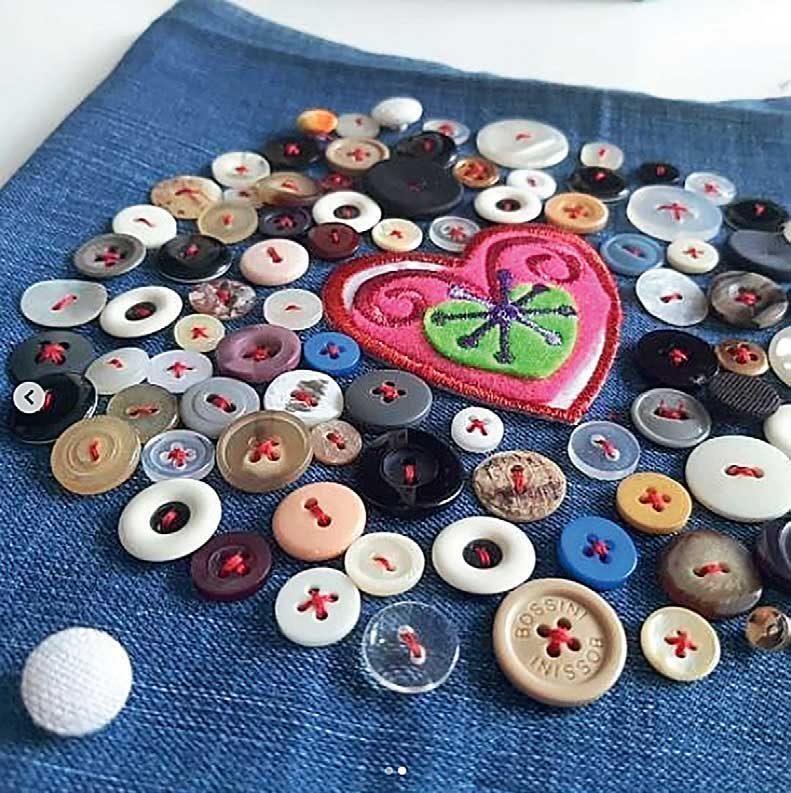
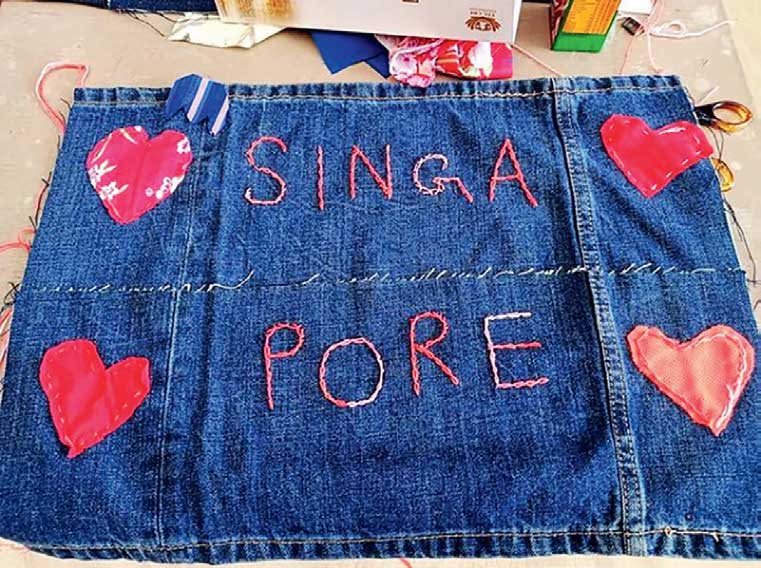
Singaporean volunteers and migrant workers came together to work on the quilt project using simple materials such as buttons, threads and fabrics, making it an easy task for even the beginners among them.
“I hope the participants come away with a shared experience of belonging, and that after each workshop, we leave with a renewed sense of humanity among us.”
Jimmy Ong, Singaporean artist
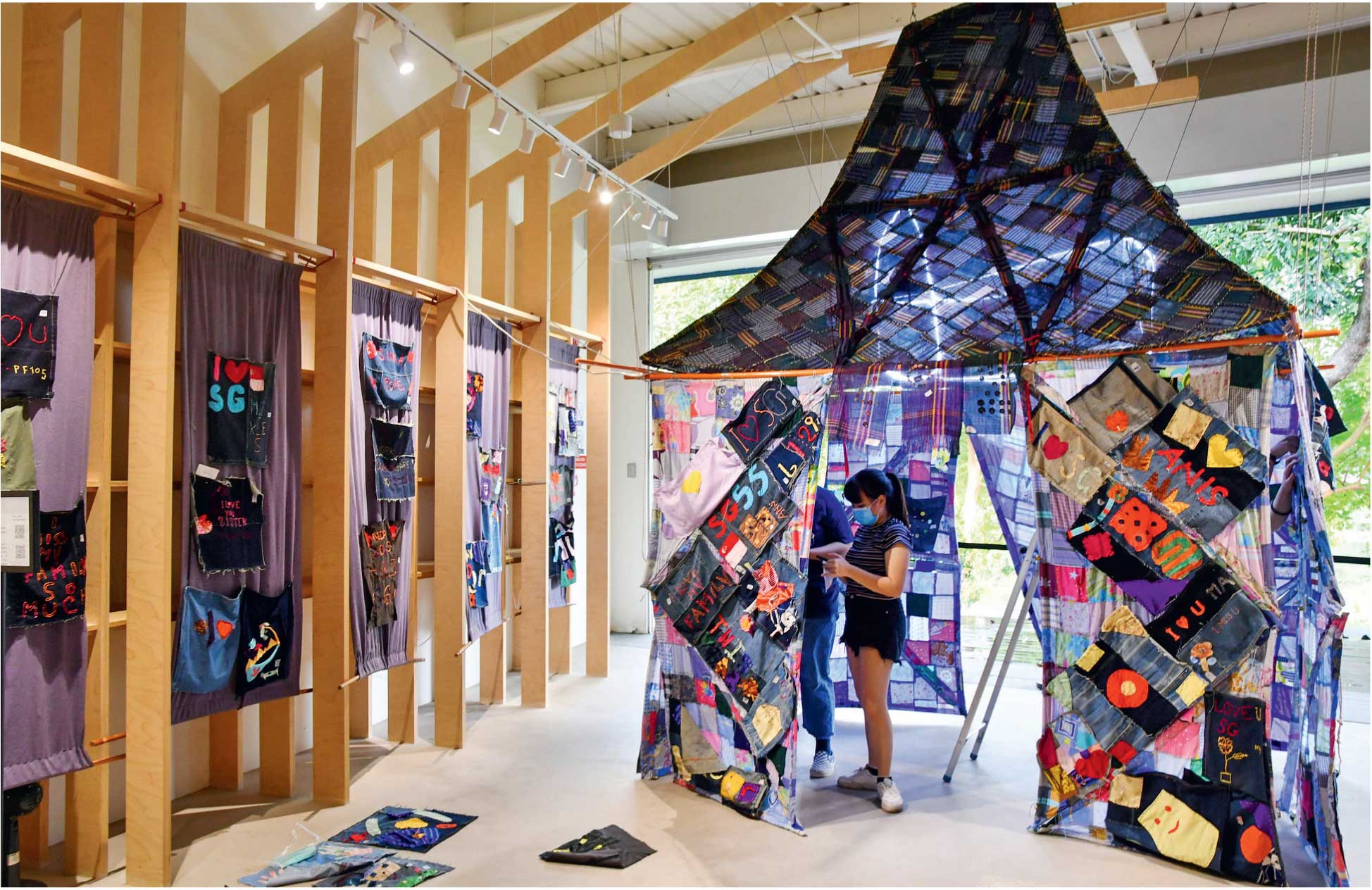
Joglo House, a purpose built installation at Singapore’s Tzu Chi Humanistic Youth Centre that is inspired by traditional Javanese houses, is the brainchild of lead artist Jimmy Ong, who used it to display the quilt pieces contributed by members of the public, the SIF’s A4G fellows and migrant workers.
The final artwork was exhibited at the end of the year. This was complemented by a digital quilt created by A4G fellow and Filipino artist Francis Sollano in collaboration with young volunteers.
Working with images taken from the individual quilt pieces contributed by people and families around the world through a public call-out, this abstract digital quilt will convey the collective pandemic experience. These may include shapes of people wearing masks or face shields overlaid with the actual images of the quilts.
Tan says that there are also plans to teach The Social Kitchen’s staff how to brew a good cup of coffee.
Before his encounter with The Social Kitchen, he says he found it difficult to find a job that had a balance between not being too strenuous and having understanding colleagues. Here, many of his colleagues are people with special needs or their caregivers, and this has inherently created a conducive and comfortable environment for learning.
Sollano highlights the significance of such cross-border collaborations. “The pandemic isn’t confined within any border. It is important to understand how other communities have kept their mental and creative health challenges at bay so that others may be inspired to work the same way or find better means.
“We may be divided by seas, yet we have this indomitable human spirit that allows us to feel and act on the same emotions. Regardless of our language or beliefs, we all wish to be well and thrive, which is why being part of a community is crucial at a time when isolation has become the new norm,” he adds.
Ong agrees. By collectively making small, individual patchworks that remotely gather to form a larger installation in a public space, as a collective coping mechanism, the project has made the pandemic a little easier to handle, he says. But he also notes its significance transcends the final installation.
“I remind myself I’m no longer making art in the conventional sense, and that the resulting installation is not the art. I hope the participants come away with a shared experience of belonging, and that after each workshop, we leave with a renewed sense of humanity among us,” he concludes.
ART WITHOUT BARRIERSA look at other Arts for Good (A4G) projects that have helped foster international connections and collaborations. ARTSEA It is a digital arts learning resource package that aims to connect children and young people from different cultural backgrounds and increase their accessibility to local art forms through creative, digital arts experiences. Highlighting 10 Southeast Asian artists, the package will be accompanied by trainer workshops as well as a social media club for the participants to form international connections. The team comprises three SIF A4G fellows — Kristin Dwek from the US, and Teng Zi Ying and Rebekah Lin from Singapore. GIFT A SONG The initiative led by Singapore music veteran Clement Chow saw 15 independent musicians come together to record song dedications and spread good cheer locally and abroad. A tribute of 88 songs – including one by Madam Halimah Yaacob, the President of Singapore and the SIF’s patron – was made to 16 countries, reaching over 1.3 million people. IN A NEW LIGHT Led by SIF A4G fellow Fiona Ferguson, the initiative is a partnership among The Artground (Singapore), Gidree Bawlee Foundation of Arts (Bangladesh) and Imaginate (Scotland). It was created for children and young people who face barriers to accessing the arts. Participants will explore their collective voices in the current ecological crisis alongside three artistes: Gudrun Soley Sigurdardottir (Edinburgh, Scotland), Kamruzzaman Shadhin (Balia, Bangladesh) and SIF A4G fellow Renee Chua (Singapore). It will also be showcased at the Edinburgh International Children’s Festival in 2021. LEGENDS OF THE SEA This art activity book explores the materials, techniques and processes of various art practices employed by practitioners from Southeast Asia. Activities are designed for children aged seven to 11 years, with an emphasis on regional cultural and artistic heritage. It is a collaboration among five SIF A4G fellows across four countries – Lee Hui Ling and Soonufat Supramaniam (Malaysia), Evelyn Ghozalli (Indonesia), Loh Wan Ting (Singapore) and Pia G. Ortiz-Luis (the Philippines). SAME-SAME Directed by SIF A4G fellow Jeffrey Tan, director of Theatre Today, with Emma Beech, an independent theatre artiste, it is produced in collaboration with Subastian Tan from Maya Dance Theatre and Michaela Cantwell from No Strings Attached Theatre of Disability. A cross-border theatre production that focuses on friendship, seven differently abled performers from Singapore and Australia came together to share their experiences living in the time of Covid-19 through concurrent online performances. |
